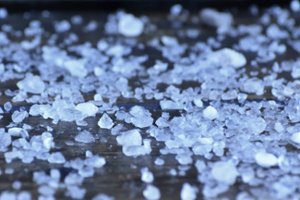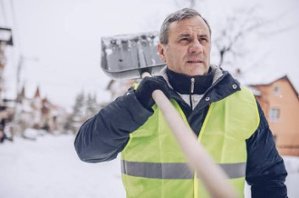
by Flagship Staff | Feb 19, 2019 | Blog
With several weeks of winter left, and then the transition to spring, salt could still play a big part in keeping your property safe. Part of being prepared is knowing the specifics of the deicers you’re using on your driveway or sidewalk. Each type of deicer has different melting properties and uses. Consider all factors when choosing the product best for you.
The most common types of ice melts on the market today are chloride based.
Sodium chloride, most commonly known as rock salt, is the most frequently used type of salt, probably because of how inexpensive it is. Working in temperatures as low as 20 degrees, this isn’t the most effective and it’s known to leave a white power behind.
Calcium chloride is probably the most effective salt-based product, because it works up to -25 degrees. Be careful when using calcium chloride. It’s known to cause harm to plants and grass and sometimes it even damages concrete if used excessively.
Potassium chloride has been deemed as the safer chloride-based option, working in temperatures as low as 12 degrees. It doesn’t work as well as other melting products, but people pick this product because it doesn’t harm vegetation.
Looking for products that aren’t chloride based?
Sodium acetate works well in colder temperatures, as low as zero degrees. Its most common use is on airplane runways.
Calcium magnesium acetate works in colder temperatures as well. Along with sodium acetate, this product is considered environmentally friendly and has a lesser chance of harming animals or vegetation.
Ethylene glycol works in extreme cold, up to -58 degrees. However, this product is incredibly harmful for people and animals. Use extreme caution with this product, it can be deadly if ingested.
A huge concern when picking salt is knowing what is and isn’t safe for children and pets.
There really isn’t a fully “safe” salt choice; all salts are harmful if ingested and can cause skin irritation. Even if not ingested directly, there are other ways salt can be ingested. Remember as you’re spreading salt out, you may also be getting it in nearby snow which your children or pets may decide to eat.
Many salts say they’re “pet friendly,” but that isn’t always the case. It’s extremely important to look at labels when selecting salt – try and find a product that doesn’t have any warning labels on it. If something isn’t safe for humans, it isn’t safe for pets either. Propylene Glycol based products are generally the safest product to have around pets.
If you’re concerned about your children or pets, look for products that don’t contain salt or chloride. These are less harmful.
Try mixing salt with some sand to decrease the amount of salt you’re using this winter. Although sand won’t melt ice like salt does, the combination will help increase traction.
As always, it’s important to read warning labels and follow manufacturer directions when using these products. When picking a deicer, take all factors into consideration and pick the product best for you and your family. There’s no such thing as being too safe, always wash your hands after using deicers and keep a close eye on children and pets.

by Flagship Staff | Feb 12, 2019 | Blog
After a quiet December, Mother Nature has really created a ruckus in Wisconsin the last several weeks. From significant amounts of snow to extremely cold temperatures, winter’s back!
If you’re fed up with shoveling, it may be time to hire a snow removal service for the remainder of the season. If you’ve recently hired a snow removal service or plan to, you should be aware of the potential risks.
Accidents happen, especially in slippery, icy conditions. What if their worker slips and falls on your driveway or causes damage to your home or to property of others? You might be held responsible. That’s why it’s important to have the proper insurance, for both you and the company, to ensure coverage for potential losses.
Here are some things to do to ensure you’re both protected:
1. Consider requesting a copy of their current Certificate of Insurance. You’ll want to look for two types of coverages:
Liability insurance covers property damage and injuries caused by their workers.
Workers’ compensation insurance provides payment to injured workers for lost wages and medical services, regardless of who was at fault.
If they can’t provide proof of insurance, don’t hire them!
2. Verify that they’re bonded.
Bonding protects you if they fail to complete a job or fail to meet other financial obligations, such as paying for damage the worker caused to your property.
To determine whether your snow removal service is bonded, ask for a bond number and certification. You should take extra precautions to ensure that both the bond and the license are up to date.
3. Make sure they bring and use their own tools and equipment.
If you offer your own equipment to them, you assume the responsibility to ensure the equipment is suitable for the job, is in safe condition, and they’re trained to use it.
4. Keep a copy of all paperwork.
Include proof of licensing (if required), bonding and insurance, the contract, invoices, proof of payment, and all letters and e-mails.
Winter can be a long season and who knows what surprises Mother Nature may have in store. Keep your surprises to a minimum this winter and be prepared if you hire help.

by Flagship Staff | Feb 5, 2019 | Blog
Here in Wisconsin, the weather is consistently throwing us for a loop. Anticipating snow and ice is something we all should do.
If you’re looking to avoid an icy driveway this winter, or you’re curious about when and how to apply salt, here’s a few tips to get you started:
Before salting, make sure to shovel your driveway or sidewalk and clear as much snow as possible. This will help the salt work directly on the icy patches.
You don’t need a ton of salt to clear the ice off your driveway. A nice even layer of salt should do the trick and help to remove ice buildup.
Each version of salt varies and has its own specified melting temperature. When selecting salt, make sure to read the manufacture instructions on the package for proper use and application. Most times, salt should begin to work within 20 minutes. If the ice isn’t melting, it may be too cold outside for that specific salt product.
Once the ice has started to melt, try and remove some of the thicker patches with a shovel to reduce re-freezing and slush. Reapply salt in extremely icy areas as needed.
Here are some additional tips to keep you and others safe:
Protect yourself when using salt by wearing a pair of gloves or using a scoop to spread the salt out. If your children are outside, keep an eye on them and make sure they don’t come into contact with any salt either!
Consider your furry family members. When brining pets inside, check their paws. Salt left on a dog’s paws can cause some significant burns and make your pup extremely uncomfortable.
Think ahead. If you’re having friends over or you’re concerned about people slipping, clear your driveway and sprinkle salt down so it has enough time to start working.
Keeping your driveway and sidewalk clear is incredibly important to avoid injury, not only to you and your family, but also to guests or neighbors.

by Flagship Staff | Jan 29, 2019 | Blog
Extreme cold temperatures put your home or business at risk for frozen pipes. As water freezes, it expands and puts pressure on pipes. When there’s too much pressure on pipes, they burst. Most times, the areas you need to be most concerned about are unheated areas, like garages and basements.
Every year, West Bend adjusters handle numerous burst pipe claims thanks to the extreme Midwest weather. Often times, these claims are on second homes or vacation properties. “These losses can be very large as the water can run for weeks,” says Scott Thomas, director of claims. In Scott’s experience, most of these situations occur when a furnace fails, or the heat is turned down too far. These losses can be minimized by someone checking on the property during extreme weather and by utilizing remote temperature monitoring technology.
Even if heat is maintained at comfortable levels, pipes on outer walls can freeze during extreme weather. Luckily, there are steps you can take to help prevent this from happening in your home or business.
1. Insulation is Key: Pipes that are exposed such as sprinkler lines or hose bibs are most likely to freeze. Garage and unheated basement pipes are also susceptible to freezing. Adding a layer of insulation to these pipes can prevent them from freezing. Go a step further and add insulation to your basement and attic to help maintain the temperature in cooler areas.
2. Monitor Your Heat: Try to keep your heat at one setting day and night. I know, heating your home or business can be very pricy but the added expense on your heating bill is much less than the cost of a broken pipe repair. If you plan to leave town for a few days, don’t set your heat to lower than 55 degrees.
3. Open Cabinets: Open your cabinet doors and allow heat to circulate around the plumbing under your cabinets.
4. Allow Water to Trickle: Keep your faucets on just enough so they drip, this keeps water moving and prevents it from freezing.
5. Prep for the Cold: Make sure outdoor hoses are removed and water is shut off to the faucets before winter.
If your pipes freeze, there are a few steps you can take to thaw them. Be cautious; if a pipe in has burst due to a freeze, water will come out and potentially flood your home or business.
Turn on your faucet.
Apply heat to the frozen area of the pipe. Because the faucet is on, as the pipe thaws, water should start to flow and come out the faucet.
Keep heating until the water is back to normal pressure. Make sure to check all faucets in your home too.
If you’re uncomfortable or unsure what to do, don’t hesitate to call a plumber.

by Flagship Staff | Jan 22, 2019 | Blog
During the winter months, Mother Nature can stir up a variety of weather conditions. Howling winds, drifting snow, and freezing rain make travel, exercise, and day-to-day living difficult.
Unfortunately, more than one million people are injured each year as a result of winter weather. Here are some common winter injuries and tips to prevent them happening to you or your family.
1. Slip and falls. Concrete or asphalt surfaces can change with each step you take. A casual walk to your car or a walk with your dog can suddenly turn into your body flailing out of control. If you’re lucky enough to catch yourself, you will probably keep walking and maybe look to see if anyone saw you. If you fall, common injuries can include:
Broken bones;
Injured back;
Sprains; and
Head injuries.
If you fall and experience extreme pain or can’t get up, call 911 immediately. If you experience other injuries, visit your local emergency department or call your doctor. Loss of consciousness, severe headache, nausea, vomiting, and confusion can be signs of a severe head injury.
To prevent yourself or others from falling:
Shovel and salt your sidewalk frequently;
Use hand rails if they’re available;
Avoid carrying items;
Keep your phone in your pocket;
Wear appropriate winter shoes; and
Watch for slippery floors when you enter your home or a building.
2. Frostbite. If you ask my neighbors, they’ll admit to seeing me shovel my sidewalk wearing only shorts, a jacket, and maybe flip flops. While they probably think I’m crazy, my thought is that I’m only going to be outside for a few minutes. Or, if you have high school kids, you know it’s not cool to wear a coat. In either foolish situation, frostbite can occur quickly.
Depending on the temperature, frostbite can occur within 10 minutes of exposure. Frostbite affects areas that are away from your core, including your feet, toes, hands, fingers, nose, and ears.
Like burns, frostbite has several degrees of injury. They are:
Frostnip is a precursor to frostbite. Your skin may be very cold or numb and turn red.
Superficial frostbite may cause your skin to become pale or white and can include the formation of ice crystals on your skin.
Deep frostbite is irreversible and may include numbness, pain, and blisters. The dead areas of skin usually become hard and black.
Here are some ways to protect you and your family from frostbite:
Wear appropriate clothing and cover up your extremities.
Wear moisture wicking socks if enjoying outdoor activities.
Drink plenty of water.
Avoid alcohol consumption.
3. Back injuries and heart attacks. Shoveling snow is very strenuous and can lead to significant injuries and even death. If you experience shortness of breath or chest pain, call 911 immediately.
Here are some tips for more effective shoveling:
Warm up your body by doing some stretches or brisk walking.
Push the snow as much as you can and avoid lifting.
Keep a slight bend in your knees to prevent back injury.
Depending on the size of your property, consider hiring a snow removal service.
Ask your neighbors for help.
4. Carbon Monoxide Poisoning (CO). Carbon monoxide is an odorless, colorless gas that can lead to death. Carbon monoxide is produced by burning fuel in your car, grill, fireplace, or furnace.
Here are some tips to prevent CO poisoning:
When warming your car during the winter months, it’s safest to move your car into your driveway. If you don’t, the gas can enter your home.
Have your gas, oil, or coal burning appliances inspected yearly by a qualified technician.
During a power outage, don’t use a gas generator or portable heating device in your home.
Install CO detectors in your home and change the backup battery in spring and fall.
5. Sports related injuries. These injuries can happen very quickly. A fun family day at your local ski hill can end sadly with injuries.
Here are some tips to ensure your day ends well:
Know your limits.
Wear appropriate equipment such as googles or helmets.
Stay hydrated and take frequent breaks.
Pay attention to your surroundings.

by Flagship Staff | Jan 18, 2019 | Blog
From smart food dispensers and surveillance systems to ingenious toys and crafty crates, tech-savvy pet products are a booming market. Dog-walking robots may not be a reality yet, but we have recommendations for keeping your pets fed, safe, and busy while you’re away. With smart home technology devices, you can take some of the stress out of pet ownership and help your pet live a happier, healthier life.
Food: Make sure mealtimes are on time.
With hectic schedules, it can be easy to forget to feed your pet on time, especially if you’re running late for work, stuck in traffic, or taking the kids to practice. A connected pet feeder makes it easy to feed your pet on time every day. Automated dispensers like the PetSafe Automatic Pet Feeder let you schedule mealtimes and deliver specific portions. You can also feed your pet through the app anytime you want.
If you have pets that need separate mealtimes, devices like the SureFeed Microchip Pet Feeder use RFID collar tags or your pets’ microchips to detect when the appropriate pet approaches the feeder. The device will only dispense food once it identifies the right animal.
Safety: Find Fido wherever he may roam.
If you have an escape artist or like to take off-leash nature walks with your pup, he may be a good candidate for a pet tracker — a GPS-enabled device that attaches to your pet’s collar. It’s lightweight enough to work for dogs of all sizes, or even cats. Use the app to establish zones where your pet usually plays or walks. If your buddy crosses the “safe place” boundary, you’ll receive an alert letting you know his location. Pet trackers like the Whistle 3 also work as fitness monitors, displaying how many calories your furry friend burned, how many miles he’s run, and how many hours he’s slept (hint: a lot!).
Security: Keep an eye on your pets.
There are a variety of WiFi-enabled cameras that let you see, hear, and talk to your pets when you’re not home.
1. Nest Cam: From the makers of Nest home security products, the Nest Cam is a high-quality indoor security camera that makes a great pet cam.
2. Wyze Cam: This security camera pans automatically, so you can always keep an eye on your animals.
3. Arlo Pro 2: For outdoor pets, this video camera is a weather-resistant, battery-powered option you can place anywhere. With an outdoor camera, you can see, hear, and talk to your pet whether you’re inside the house or across town at work.
4. Eyenimal Cat Video Camera: For a fun twist on a pet cam, attach this tiny camera to your pet’s collar to check out where she goes on her walkabouts. It has night vision, is water resistant, and will record two-three hours of video at a time.
Entertainment: Pet-friendly connected toys.
It’s hard not to feel guilty when you have to leave your pet home alone. Thankfully, technology has given us creative ways to keep our fur babies entertained (without chewing shoes or clawing the sofa). As a bonus, some of these devices even let you keep in touch with your pets wherever you are. Here are a few entertainment devices your pet might love:
The Interactive Cube: The PetCube Play is a sophisticated-looking black cube equipped with a camera. You can see your pet through a live video feed on your smartphone and “play” with her using a built-in laser toy that you operate via the app. You can also set the PetCube on a schedule, which is great for days when you can’t take a break to play.
The Substitute Ball Thrower: It’s as simple and ingenious as it sounds. The iFetch Interactive Ball Launcher for Dogs throws the ball for your dog to retrieve. Once you teach your pup how to return the ball to the launcher, she’ll quickly learn how to entertain herself for hours at a time. The iFetch works indoors or outdoors and has different sized balls for any size dog.
The Entertainment Center: Chat with your cat or dog no matter where you are using the PetChatzHD. Attach the camera to your wall at critter height to communicate with your pet via two-way audio. Use your PetChatzHD to have a video call with your pet or switch the channel to DOGTV. It can dispense treats and even has an accessory called PawCall that lets your pet call you on your phone or play games when you’re away. If your pet is willing to learn a few tricks, the PetChatzHD has endless ways to keep him entertained.
Comfort: Help calm your fearful friend.
It can be heartbreaking to know your pet is scared or anxious. Whether he’s set off by fireworks, vacuum cleaners, the garbage truck, or thunderstorms, anxiety is a common problem for many pets. When you can’t comfort him, provide him a safe space to relax with a safe nest like ZenCrate.
This crate filters out noise as an innovative solution for animals who startle easily. It’s designed to keep loud noises out and soothing noises in. The crate detects when an animal goes inside and begins playing soft, calming music. With reduced light exposure and vibration damping technology, this crate will become your pup’s sanctuary from an overstimulating world. Use the ZenCrate WiFi camera to check in on him when you’re out. The camera streams live video of your pup or kitty in the ZenCrate and sends a notification when he enters or exits the crate.
Our pets would do anything for us, so it’s our job to care for them the best we can. These high-tech, pet-friendly gadgets can help keep your best buddy happy, relieve boredom, and make your life just a little bit easier.






